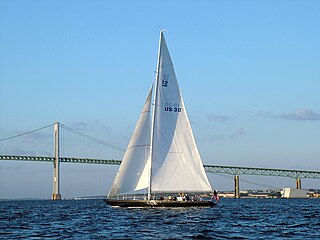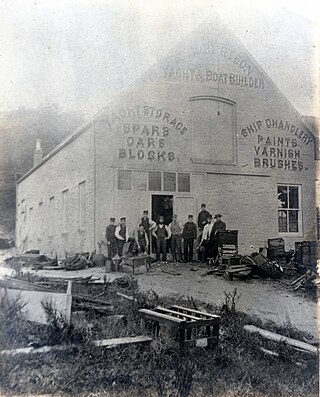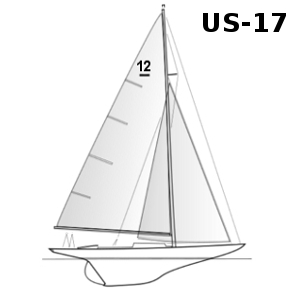
The River Clyde is a river that flows into the Firth of Clyde, in the west of Scotland. It is the ninth-longest river in the United Kingdom, and the third longest in Scotland after the River Tay and the River Spey. It runs through the city of Glasgow. The River Clyde estuary has an upper tidal limit located at the tidal weir next to Glasgow Green.

The America's Cup is a sailing competition and the oldest international competition still operating in any sport. America's Cup match races are held between two sailing yachts: one from the yacht club that currently holds the trophy and the other from the yacht club that is challenging for the cup. The winner is awarded the America's Cup trophy, informally known as the Auld Mug. Matches are held several years apart on dates agreed between the defender and the challenger. There is no fixed schedule, but the races have generally been held every three to four years. The most recent America's Cup match took place in March 2021.

James Gordon Bennett Jr. was an American publisher. He was the publisher of the New York Herald, founded by his father, James Gordon Bennett Sr. (1795–1872), who emigrated from Scotland. He was generally known as Gordon Bennett to distinguish him from his father. Among his many sports-related accomplishments he organized both the first polo match and the first tennis match in the United States, and he won the first trans-oceanic yacht race. He sponsored explorers including Henry Morton Stanley's trip to Africa to find David Livingstone, and the ill-fated USS Jeannette attempt on the North Pole.

The Holy Loch is a sea loch, a part of the Cowal Peninsula coast of the Firth of Clyde, in Argyll and Bute, Scotland.

Sandbank is a village on the Cowal Peninsula in Argyll and Bute, west of Scotland. It is located 2.5 miles north of Dunoon on the coastal A815 or the inland A885 and sits on the southern shore of the Holy Loch, branching off the Firth of Clyde.

The New York Yacht Club (NYYC) is a private social club and yacht club based in New York City and Newport, Rhode Island. It was founded in 1844 by nine prominent sportsmen. The members have contributed to the sport of yachting and yacht design. As of 2001, the organization was reported to have about 3,000 members. Membership in the club is by invitation only. Its officers include a commodore, vice-commodore, rear-commodore, secretary and treasurer.

The 12 Metre class is a rating class for racing sailboats that are designed to the International rule. It enables fair competition between boats that rate in the class whilst retaining the freedom to experiment with the details of their designs. The designation "12 Metre" does not refer to any single measurement on the boat, and is not referencing the vessels overall length, rather, measures the sum of the components directed by the formula which governs design and construction parameters. Typically 12 Metre class boats range from 65 to 75 feet in length overall; they are most often sloop-rigged, with masts roughly 85 feet tall.

William Fife Jr., also known as William Fife III, was the third generation of a family of Scottish yacht designers and builders. In his time, William Fife designed around 600 yachts, including two contenders for the America's Cup. The Royal Yachting Association was formed in 1875 to standardise rules, and Fife and his rival G.L. Watson, were instrumental in these rule changes. Around one third of Fife's yachts still exist. His last designs were built in 1938.

Nathanael Greene Herreshoff was an American naval architect, mechanical engineer, and yacht design innovator. He produced a succession of undefeated America's Cup defenders between 1893 and 1920.

The J Class of racing yachts were built to the specifications of Nathanael Herreshoff's Universal Rule. The J Class is considered the apex of the era when the Universal Rule determined eligibility in the America's Cup.
Alexander Smith Cochran was a manufacturer, sportsman and philanthropist from Yonkers, New York.

Alexander Robertson & Sons was a boatyard in Sandbank, Argyll and Bute, Scotland, from 1876 to 1980. The yard was located on the shore of the Holy Loch, not far from the Royal Clyde Yacht Club (RCYC) at Hunters Quay, in the building that is now the Royal Marine Hotel, which was the epicentre of early Clyde yachting. Alexander Robertson started repairing boats in a small workshop at Sandbank in 1876, and went on to become one of the foremost wooden boatbuilders on Scotland's River Clyde. The "golden years" of Robertson's yard were in the early 1900s, when it started building some of the first IYRU 12mR & 15mR racing yachts. Robertson's was well known for the quality of its workmanship and was chosen to build the first 15-metre yacht designed by William Fife III. More than 55 boats were built by Robertson's in preparation for the First World War and the yard remained busy even during the Great Depression in the 1930s as many wealthy businessmen developed a passion for yacht racing on the Clyde. During World War II the yard was devoted to Admiralty work, producing a wide range of large high-speed Fairmile Marine Motor Boats. After the war, the yard built the successful one-class Loch Longs and two 12-metre challengers for the America's Cup: Sceptre (1958) and Sovereign (1964). Due to difficult business conditions, the Robertson family sold the yard in 1965, and it was turned over to glass-reinforced plastic production work until it closed in 1980. During its 104-year history, Robertson's Yard built 482 numbered boats, many of which are still sailing today.

The 1962 America's Cup, the second to be sailed in 12-metre yachts, marked the first challenge for the Cup from a country other than Great Britain or Canada, and was the first challenge from a country in the southern hemisphere. An Australian syndicate headed by Sir Frank Packer, representing the Royal Sydney Yacht Squadron, challenged with their yacht Gretel. Although the New York Yacht Club won the regatta four races to one represented by the yacht Weatherly, the challenger, Gretel won the second race, beating the Americans for the first time since the 1930s, and only lost the fourth race by twenty-six seconds. The NYYC was so shocked at the closeness of the contest that they immediately changed the rules to ban the use of American design and technology by Cup challengers.

The 1958 America's Cup marked the first Cup match sailed in 12-metre class yachts. Twenty years had passed since the last Cup match, held between immense Universal Rule J-class yachts in 1937 besides World War II, and the New York Yacht Club sought a more affordable alternative to restart interest in the Cup. In 1956 Henry Sears led an effort advancing class yachts. The Royal Yacht Squadron of Great Britain agreed to challenge with a new 12-metre, Sceptre. The New York Yacht Club defended with theirs, Columbia, winning the Cup in a four-race sweep.

Columbia (US-16) was the successful defender of the 1958 America's Cup for the New York Yacht Club, besting the British challenger Sceptre.

Weatherly is a 12-metre racing yacht that was an unsuccessful defense candidate for the 1958 America's Cup and victorious defender in the 1962 America's Cup.

Sappho was one of two defender yachts at the second America's Cup challenge, stepping in when defender Columbia was damaged in the third race.

Sovereign was the unsuccessful challenger of the 1964 America's Cup for the Royal Thames Yacht Club.

Franklin Osgood was a 19th-century businessman and yachtsman. He was an experienced yachtsman having sailed for more than 23 years. He was owner and manager of the racing yachts Widgeon, Columbia, and Magic. He was the first defender and two-time winner of the America's Cup. Osgood was inducted into the America's Cup Hall of Fame in 2020.
William H. Brown was an American shipbuilder during the 19th-century. He built yachts, paddle steamers and steamboats. He was one of the first shipbuilders in the country and had his business for more than thirty years having built over 300 vessels. He built the yacht America, which was the first winner of the America's Cup; the paddle steamer SS Arctic; and the sidewheel steamer Pacific, as well as other fine ships.
















